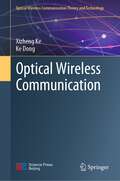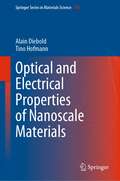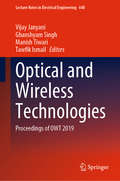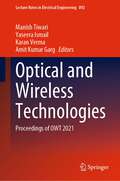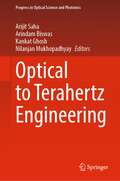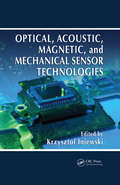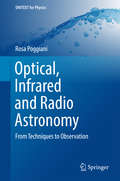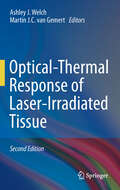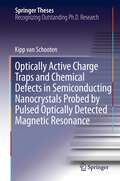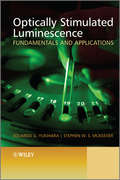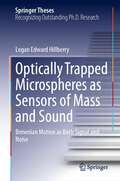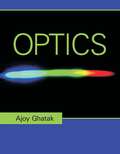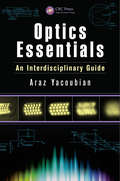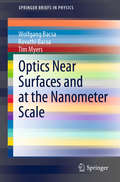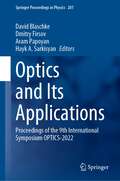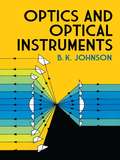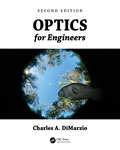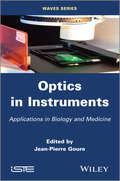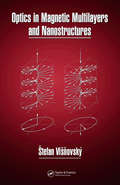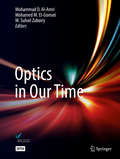- Table View
- List View
Optical Wireless Communication (Optical Wireless Communication Theory and Technology)
by Ke Dong Xizheng KeThe book gives a detailed description of optical wireless communication (OWC), including optical laser communication, visible light communication, ultraviolet communication, underwater optical communication and future communication technologies. To achieve an integration between theory and practice, the book avoids tedious mathematical deductions and includes theoretical materials as exercises. Most of the exercises are originated from published journal articles. These exercises will aid the readers in understanding the basic concept and methods and evaluating their knowledge acquisition in the field of OWC. The book is structured into Ten chapters that covers main aspects of OWC: - Optical wireless communication system - Coherent optical communication - Modulation, demodulation, and coding - Atmospheric channel, channel estimation, and channel equalization - White LED communication - Underwater laser communication - Ultraviolet communication - Acquisition, aiming, and tracking technology - Partially coherent optical transmission - Optical communication in the future The book is a suitable reference for undergraduate or postgraduate students majored in communication engineering, electronic information engineering or computer science, as well as the engineers and technicians in related fields.
Optical and Electrical Properties of Nanoscale Materials (Springer Series in Materials Science #318)
by Alain Diebold Tino HofmannThis book covers the optical and electrical properties of nanoscale materials with an emphasis on how new and unique material properties result from the special nature of their electronic band structure. Beginning with a review of the optical and solid state physics needed for understanding optical and electrical properties, the book then introduces the electronic band structure of solids and discusses the effect of spin orbit coupling on the valence band, which is critical for understanding the optical properties of most nanoscale materials. Excitonic effects and excitons are also presented along with their effect on optical absorption.2D materials, such as graphene and transition metal dichalcogenides, are host to unique electrical properties resulting from the electronic band structure. This book devotes significant attention to the optical and electrical properties of 2D and topological materials with an emphasis on optical measurements, electrical characterization of carrier transport, and a discussion of the electronic band structures using a tight binding approach. This book succinctly compiles useful fundamental and practical information from one of the fastest growing research topics in materials science and is thus an essential compendium for both students and researchers in this rapidly moving field.
Optical and Laser Diagnostics: Proceedings of the First International Conference London, 16-20 December 2002 (Institute of Physics Conference Series)
by C Arcoumanis and K TV GrattanFrom the automotive industry to blood flow monitoring, optical techniques and laser diagnostics are becoming integral parts in engineering and medical instrumentation. Written by leading global experts from industry, academic groups, and laboratories, this volume provides an international perspective on both existing applications and leading-edge r
Optical and Wireless Convergence for 5G Networks (Wiley - IEEE)
by Abdelgader M AbdallaThe mobile market has experienced unprecedented growth over the last few decades. Consumer trends have shifted towards mobile internet services supported by 3G and 4G networks worldwide. Inherent to existing networks are problems such as lack of spectrum, high energy consumption, and inter-cell interference. These limitations have led to the emergence of 5G technology. It is clear that any 5G system will integrate optical communications, which is already a mainstay of wide area networks. Using an optical core to route 5G data raises significant questions of how wireless and optical can coexist in synergy to provide smooth, end-to-end communication pathways. Optical and Wireless Convergence for 5G Networks explores new emerging technologies, concepts, and approaches for seamlessly integrating optical-wireless for 5G and beyond. Considering both fronthaul and backhaul perspectives, this timely book provides insights on managing an ecosystem of mixed and multiple access network communications focused on optical-wireless convergence. Topics include Fiber–Wireless (FiWi), Hybrid Fiber-Wireless (HFW), Visible Light Communication (VLC), 5G optical sensing technologies, approaches to real-time IoT applications, Tactile Internet, Fog Computing (FC), Network Functions Virtualization (NFV), Software-Defined Networking (SDN), and many others. This book aims to provide an inclusive survey of 5G optical-wireless requirements, architecture developments, and technological solutions.
Optical and Wireless Technologies: Proceedings of OWT 2019 (Lecture Notes in Electrical Engineering #648)
by Ghanshyam Singh Vijay Janyani Manish Tiwari Tawfik IsmailThis volume presents selected papers from the 3rd International Conference on Optical and Wireless Technologies, conducted from 16th to 17th March, 2019. It focuses on extending the limits of currently used systems encompassing optical and wireless domains, and explores the latest developments in applications like photonics, high speed communication systems and networks, visible light communication, nano-photonics, wireless, and MIMO systems. The proceedings contain high quality scholarly articles, giving insight into the analytical, experimental, and developmental aspects of systems, techniques, and devices in these spheres. This volume will prove useful to researchers and professionals alike.
Optical and Wireless Technologies: Proceedings of OWT 2020 (Lecture Notes in Electrical Engineering #771)
by Ashok Kumar Manish Tiwari Preecha Yupapin Ravi Kumar Maddila Amit Kumar GargThis book comprises select proceedings of the 4th International Conference on Optical and Wireless Technologies (OWT 2020). The contents of this volume focus on research carried out in the areas of Optical Communication, Optoelectronics, Optics, Wireless Communication, Wireless Networks, Sensors, Mobile Communications and Antenna and Wave Propagation. The volume also explores the combined use of various optical and wireless technologies in next generation applications, and their latest developments in applications like photonics, high speed communication systems and networks, visible light communication, nanophotonics, wireless and MIMO systems. This book will serve as a useful reference to scientists, academicians, engineers and policy-makers interested in the field of optical and wireless technologies.
Optical and Wireless Technologies: Proceedings of OWT 2021 (Lecture Notes in Electrical Engineering #892)
by Manish Tiwari Amit Kumar Garg Yaseera Ismail Karan VermaThis book comprises select proceedings of the 5th International Conference on Optical and Wireless Technologies (OWT 2021). The contents of this book focus on research carried out in optical communication, optoelectronics, optics, wireless communication, wireless networks, sensors, mobile communications, and antenna and wave propagation. The book also explores the combined use of various optical and wireless technologies in next-generation applications and their latest developments in the applications such as photonics, high-speed communication systems and networks, visible light communication, nanophotonics, and wireless and MIMO systems. This book serves as a reference to scientists, academicians, engineers, and policy-makers interested in the field of optical and wireless technologies.
Optical to Terahertz Engineering (Progress in Optical Science and Photonics #23)
by Arindam Biswas Arijit Saha Kankat Ghosh Nilanjan MukhopadhyayThis book highlights advances in the field of THz engineering along with limitations of radio frequency (RF) technology. All engineering applications have been designed to operate over a specific frequency or wavelength range in electromagnetic spectrum. In recent years, the unexplored domain of THz range of electromagnetic spectrum has paved the way for terahertz technology due to its nonionizing nature and sensitivity to water content. A wide range of applications with THz techniques such as terahertz time-domain spectroscopy (THz-TDS), biological, medical and pharmaceutical sciences, explosives inspection, information and communication technology (ICT) sector and many more, have potential to be the technology of future. Different designing aspects and evolving application areas are addressed to enrich the technical knowledge of readers. This book provides an overview of state of the art in terms of research and industrial progress in THz spectrum.
Optical, Acoustic, Magnetic, and Mechanical Sensor Technologies (Devices, Circuits, and Systems)
by Krzysztof IniewskiLight on physics and math, with a heavy focus on practical applications, Optical, Acoustic, Magnetic, and Mechanical Sensor Technologies discusses the developments necessary to realize the growth of truly integrated sensors for use in physical, biological, optical, and chemical sensing, as well as future micro- and nanotechnologies. Used to pick up sound, movement, and optical or magnetic signals, portable and lightweight sensors are perpetually in demand in consumer electronics, biomedical engineering, military applications, and a wide range of other sectors. However, despite extensive existing developments in computing and communications for integrated microsystems, we are only just now seeing real transformational changes in sensors, which are critical to conducting so many advanced, integrated tasks. This book is designed in two sections—Optical and Acoustic Sensors and Magnetic and Mechanical Sensors—that address the latest developments in sensors. The first part covers: Optical and acoustic sensors, particularly those based on polymer optical fibers Potential of integrated optical biosensors and silicon photonics Luminescent thermometry and solar cell analyses Description of research from United States Army Research Laboratory on sensing applications using photoacoustic spectroscopy Advances in the design of underwater acoustic modems The second discusses: Magnetic and mechanical sensors, starting with coverage of magnetic field scanning Some contributors’ personal accomplishments in combining MEMS and CMOS technologies for artificial microsystems used to sense airflow, temperature, and humidity MEMS-based micro hot-plate devices Vibration energy harvesting with piezoelectric MEMS Self-powered wireless sensing As sensors inevitably become omnipresent elements in most aspects of everyday life, this book assesses their massive potential in the development of interfacing applications for various areas of product design and sciences—including electronics, photonics, mechanics, chemistry, and biology, to name just a few.
Optical, Infrared and Radio Astronomy
by Rosa PoggianiThis textbook presents the established sciences of optical, infrared, and radio astronomy as distinct research areas, focusing on the science targets and the constraints that they place on instrumentation in the different domains. It aims to bridge the gap between specialized books and practical texts, presenting the state of the art in different techniques. For each type of astronomy, the discussion proceeds from the orders of magnitude for observable quantities that drive the building of instrumentation and the development of advanced techniques. The specific telescopes and detectors are then presented, together with the techniques used to measure fluxes and spectra. Finally, the instruments and their limits are discussed to assist readers in choice of setup, planning and execution of observations, and data reduction. The volume also includes worked examples and problem sets to improve student understanding; tables and figures in chapters summarize the state of the art of instrumentation and techniques.
Optical-Thermal Response of Laser-Irradiated Tissue
by Ashley J. Welch Martin J.C. GemertThe second edition maintains the standard of excellence established in the first edition, while adjusting the content to reflect changes in tissue optics and medical applications since 1995. The material concerning light propagation now contains new chapters devoted to electromagnetic theory for coherent light. The material concerning thermal laser-tissue interactions contains a new chapter on pulse ablation of tissue. The medical applications section now includes several new chapters on Optical Coherent Tomography, acoustic imaging, molecular imaging, forensic optics and nerve stimulation. A detailed overview is provided of the optical and thermal response of tissue to laser irradiation along with diagnostic and therapeutic examples including fiber optics. Sufficient theory is included in the book so that it is suitable for a one or two semester graduate or for senior elective courses. Material covered includes (1) light propagation and diagnostic application; (2) the thermal response of tissue and therapeutic application; (3) denaturation; and (4) ablation. The theory and applications provide researchers with sufficient detail that this volume will become the primary reference for laser-tissue interactions and medical applications.
Optically Active Charge Traps and Chemical Defects in Semiconducting Nanocrystals Probed by Pulsed Optically Detected Magnetic Resonance
by Kipp Van SchootenColloidal nanocrystals show much promise as an optoelectronics architecture due to facile control over electronic properties afforded by chemical control of size, shape, and heterostructure. Unfortunately, realizing practical devices has been forestalled by the ubiquitous presence of charge "trap" states which compete with band-edge excitons and result in limited device efficiencies. Little is known about the defining characteristics of these traps, making engineered strategies for their removal difficult. This thesis outlines pulsed optically detected magnetic resonance as a powerful spectroscopy of the chemical and electronic nature of these deleterious states. Counterintuitive for such heavy atom materials, some trap species possess very long spin coherence lifetimes (up to 1.6 µs). This quality allows use of the trapped charge's magnetic moment as a local probe of the trap state itself and its local environment. Beyond state characterization, this spectroscopy can demonstrate novel effects in heterostructured nanocrystals, such as spatially-remote readout of spin information and the coherent control of light harvesting yield.
Optically Stimulated Luminescence
by Stephen W. Mckeever Eduardo G. YukiharaOptically stimulated luminescence has developed into one of the leading optical techniques for the measurement and detection of ionizing radiation. This text covers, in a readable manner, advanced modern applications of the technique, how it can play a useful role in different areas of dosimetry and how to approach the challenges presented when working with optically stimulated luminescence.The six chapters are as follows:Introduction, including a short history of OSL and details of successful applications Theory and Practical Aspects Personal Dosimetry Space Dosimetry Medical Dosimetry Other Applications and Concepts, including retrospective and accident dosimetry, environmental monitoring and UV dosimetry Throughout the book, the underlying theory is discussed on an as-needed basis for a complete understanding of the phenomena, but with an emphasis of the practical applications of the technique. The authors also give background information and relevant key references on each method, inviting the reader to explore deeper into the subject independently.Postgraduates, researchers, and those involved with radiation dosimetry will find this book particularly useful. The material is both relevant and accessible for both specialists and those new to the field, therefore is fundamental to any academic interested in modern advances of the subject.
Optically Trapped Microspheres as Sensors of Mass and Sound: Brownian Motion as Both Signal and Noise (Springer Theses)
by Logan Edward HillberryThis thesis makes significant advances in the use of microspheres in optical traps as highly precise sensing platforms. While optically trapped microspheres have recently proven their dominance in aqueous and vacuum environments, achieving state-of-the-art measurements of miniscule forces and torques, their sensitivity to perturbations in air has remained relatively unexplored. This thesis shows that, by uniquely operating in air and measuring its thermally-fluctuating instantaneous velocity, an optically trapped microsphere is an ultra-sensitive probe of both mass and sound. The mass of the microsphere is determined with similar accuracy to competitive methods but in a fraction of the measurement time and all while maintaining thermal equilibrium, unlike alternative methods. As an acoustic transducer, the air-based microsphere is uniquely sensitive to the velocity of sound, as opposed to the pressure measured by a traditional microphone. By comparison to state-of-the-art commercially-available velocity and pressure sensors, including the world’s smallest measurement microphone, the microsphere sensing modality is shown to be both accurate and to have superior sensitivity at high frequencies. Applications for such high-frequency acoustic sensing include dosage monitoring in proton therapy for cancer and event discrimination in bubble chamber searches for dark matter. In addition to reporting these scientific results, the thesis is pedagogically organized to present the relevant history, theory, and technology in a straightforward way.
Optics
by Ajoy GhatakOptics by Professor Ghats is a classic text designed to provide a comprehensive account of important topics in this exciting field. The book aims to meet the requirements of a course on Optics for undergraduate students of science and engineering. This brand new multi-colour edition comes with a number of careful revisions in the text and colourful illustrations, thus making it even more exciting and reader friendly.
Optics Essentials: An Interdisciplinary Guide
by Araz YacoubianA Valuable Reference for Understanding Basic Optical Principals Need a crash course in optics? If you are a non-specialist with little or no knowledge of optical components, systems, or hardware, who suddenly finds it necessary to work with optics in your given field, then Optics Essentials: An Interdisciplinary Guide is the book for you. Aimed at engineers and other interdisciplinary professionals tackling optics-related challenges, this text provides a basic overview of optical principles, concepts, and applications as well as worked examples throughout. It enables readers to gain a basic understanding of optics and sense of optical phenomena, without having to commit to extended periods of study. Contains MATLAB® Simulations and Suggested Experiments The book provides MATLAB simulations to help the reader visualize concepts, includes simple experiments using everyday materials that are readily available to solidify optical principles, and provides worked examples throughout. It contains a set of suggested experiments in each chapter designed to help the reader understand and visualize the basic principles. While this book assumes that the reader has a basic background in mathematics, it does not burden or overwhelm them with complex information or heavy mathematical equations. In addition, while it also briefly discusses advanced topics, readers are directed to the appropriate texts for more detailed study. Comprised of 11 chapters, this illuminating text: Describes light sources, such as lasers, light-emitting diodes, and thermal sources Compares various light sources, and photometric and radiometric parameters Discusses light detection, including various detector types, such as photon detectors and thermal detectors, and other topics relating to light detection Addresses manipulation of light, and covers reflection, refraction, diffraction and interference, absorption, and scattering Factors in polarization Explores the basic principles of geometrical optics, covering ray tracing and formulation based on the assumption that light comprises of optical "rays" Defines imaging systems and topics related to imaging systems Refers to guiding light waves Considers various topics related to optics, electronics, software, and applications Covers combining optical systems with electronics and software Presents various optical sensing phenomena and different types of sensors Optics Essentials: An Interdisciplinary Guide simplifies optical principles to make it easy to grasp by technical professionals that are outside of the optical field, and serves industry professionals, technical managers, researchers, and students.
Optics Near Surfaces and at the Nanometer Scale (SpringerBriefs in Physics)
by Tim Myers Wolfgang Bacsa Revathi BacsaThis book explores the physical phenomena underlying the optical responses of nanoscale systems and uses this knowledge to explain their behavior, which is very different to what is encountered on the macroscopic scale. In the first three chapters, the authors discuss important aspects of wave optics on surfaces and at small scales, such as the optical interference near surfaces, the physical origin of the index of refraction, and how imaging optical fields can be used to enhance resolution in optical diffraction microscopy. The last two chapters treat a concept on the consequence of the finite size of the focal spot in optical spectroscopy and how the index of refraction can be related to scattering of an ensemble of discrete scatterers. The concepts described here are important to understanding the optical properties of nanoparticles or nanostructured surfaces and are not covered in most fundamental optics courses. This book is designed for researchers and graduate students looking for an introduction to optics at small scales.
Optics and Its Applications: Proceedings of the 9th International Symposium OPTICS-2022 (Springer Proceedings in Physics #281)
by David Blaschke Dmitry Firsov Aram Papoyan Hayk A. SarkisyanThis book features selected articles based on contributions presented at the 9th International Symposium on Optics and Its Applications (OPTICS-2022) in Yerevan-Ashtarak, Armenia. The annual OPTICS symposium brings together renowned experts from all over the world working in the fields of atomic optics, plasmonics, optics of nanostructures, as well as the optics of condensed matter, and provides a perfect setting for their discussions of the most recent developments in this area.The 9th iteration in this series, dedicated to the 80th birthday of Academician Eduard Kazaryan, focuses on topics dealing with the spectroscopy of real and artificial atoms, linear and nonlinear optical characteristics of quantum wells, and two-dimensional materials. The book highlights recent results of few-particle optical characteristics of artificial atoms in the framework of the exactly solvable Moshinsky model, as well as an electro-optical analog of the magneto-optical Faraday effect. In addition, a detailed study of the nucleation process, its characterization, as well as electronic and optical properties of graded composition quantum dots in the Stranski−Krastanov growth mode, is presented.
Optics and Optical Instruments: An Introduction
by B. K. JohnsonThis book illustrates basic practical applications of optical principle. Working models of telescopes, microscopes, photographic lenses, and optical projection systems are diagrammed and explained in full, as are the basic experiments for determining accuracy, power, angular field of view, amount of aberration, and all other necessary facts about the instrument. Throughout the book, only elementary mathematics is used, for the benefit of the student and the beginner in the field of optics.The author, an assistant professor at the Imperial College of Science and Technology in London, shows how to set up working models of each of the four types of instruments named above, so that the reader can see for himself the effects of changing the focal length, using different types of lenses, rotating the lens, and other experiments. He also includes a number of experiments to illustrate theoretical principles such as the reflection and refraction of light and focal length measurements of concave and convex lenses.A chapter on the human eye follows, and the author explains how to set up a simple working model of the eye in order to illustrate myopia, astigmatism, hypermetropia, and the visual acuity of the eye. Professor Johnson concludes with an important chapter on the working and testing of optical glass, in which he describes the roughing of lenses, the principles of the grinding and polishing processes, abrasives, edging, angle measurement, and other important steps in the production of optical glass. An appendix is included on the cleaning of glass surfaces, silvering, photographic items, developers, collodion films, and waxes and cements used for various purposes in optical work.This is a valuable work for the student and the amateur hobbyist as well as for many who use optical instruments in science and industry. It is written clearly and economically, with the needs of the practical worker in the field of optics held constantly in mind.
Optics and Photonics
by Committee on Harnessing Light: Capitalizing on Optical Science Trends Challenges for Future ResearchOptics and photonics technologies are ubiquitous: they are responsible for the displays on smart phones and computing devices, optical fiber that carries the information in the internet, advanced precision manufacturing, enhanced defense capabilities, and a plethora of medical diagnostics tools. The opportunities arising from optics and photonics offer the potential for even greater societal impact in the next few decades, including solar power generation and new efficient lighting that could transform the nation's energy landscape and new optical capabilities that will be essential to support the continued exponential growth of the Internet. As described in the National Research Council report Optics and Photonics: Essential Technologies for our Nation, it is critical for the United States to take advantage of these emerging optical technologies for creating new industries and generating job growth. The report assesses the current state of optical science and engineering in the United States and abroad--including market trends, workforce needs, and the impact of photonics on the national economy. It identifies the technological opportunities that have arisen from recent advances in, and applications of, optical science and engineering. The report also calls for improved management of U. S. public and private research and development resources, emphasizing the need for public policy that encourages adoption of a portfolio approach to investing in the wide and diverse opportunities now available within photonics. Optics and Photonics: Essential Technologies for our Nation is a useful overview not only for policymakers, such as decision-makers at relevant Federal agencies on the current state of optics and photonics research and applications but also for individuals seeking a broad understanding of the fields of optics and photonics in many arenas.
Optics for Engineers
by Charles A. DiMarzioThis textbook provides an accessible introduction to the fundamentals of geometric and physical optics as they relate to practical problems encountered by engineers and researchers in designing and analyzing optical systems.In this updated edition, the author focuses on topics that are critical to understanding how the basic principles of optics affect design decisions. In addition to information on breadboarding experiments and prototypes, the new edition also expands its coverage of diffraction and includes numerous complete examples, and practical remindersProfessor Charles A. DiMarzio is an associate professor in the Department of Electrical and Computer Engineering, the Department of Mechanical and Industrial Engineering, and the Department of Bioengineering at Northeastern University in Boston, Massachusetts. He spent 14 years at Raytheon Company’s Electro-Optics Systems Laboratory in coherent laser radar for air safety and meteorology. Among other projects there, he worked on an airborne laser radar, flown on the Galileo-II, to monitor airflow related to severe storms, pollution, and wind energy, and another laser radar to characterize the wake vortices of landing aircraft. His current research in biomedical optics focuses on microscopy including coherent imaging, structured illumination, and multi-modal imaging. He is also a founding member of Gordon-CenSSIS – the Gordon Center for Subsurface Sensing and Imaging Systems.
Optics in Instruments: Applications in Biology and Medicine (Wiley-iste Ser.)
by Jean-Pierre GoureOptics is a science which covers a very large domain and is experiencing indisputable growth. It has enabled the development of a considerable number of instruments, the optical component or methodology of which is often the essential part of portent systems. This book sets out show how optical physical phenomena such as lasers – the basis of instruments of measurement – are involved in the fields of biology and medicine. Optics in Instruments: Applications in Biology and Medicine details instruments and measurement systems using optical methods in the visible and near-infrared, as well as their applications in biology and medicine, through looking at confocal laser scanning microscopy, the basis of instruments performing in biological and medical analysis today, and flow cytometry, an instrument which measures at high speed the parameters of a cell passing in front of one or more laser beams. The authors also discuss optical coherence tomography (OCT), which is an optical imaging technique using non-contact infrared light, the therapeutic applications of lasers, where they are used for analysis and care, and the major contributions of plasmon propagation in the field of life sciences through instrumental developments, focusing on propagating surface plasmons (PSP) and localized plasmons (LP). Contents: 1. Confocal Laser Scanning Microscopy, Thomas Olivier and Baptiste Moine. 2. Flow Cytometry (FCM) Measurement of Cells in Suspension, Odile Sabido. 3. Optical Coherence Tomography, Claude Boccara and Arnaud Dubois. 4. Therapeutic Applications of Lasers, Geneviève Bourg-Heckly and Serge Mordon. 5. Plasmonics, Emmanuel Fort. About the Authors Jean-Pierre Goure is Emeritus Professor of optics at Jean Monnet University in Saint-Etienne, France, and was previously director of the UMR 5516 laboratory linked with CNRS. He is the author of more than 100 publications in various fields, such as spectroscopy, instrumentation, sensors, optical fiber and optical communications. He was also previously deputy director in engineering science at CNRS and a member of several scientific associations such as the French Optical Society and the European Optical Society.
Optics in Magnetic Multilayers and Nanostructures (Optical Science and Engineering)
by Stefan VisnovskyIn the continuing push toward optical computing, the focus remains on finding and developing the right materials. Characterizing materials, understanding the behavior of light in these materials, and being able to control the light are key players in the search for suitable optical materials. Optics in Magnetic Multilayers and Nanostructures presents an accessible introduction to optics in anisotropic magnetic media.While most of the literature presents only final results of the complicated formulae for the optics in anisotropic media, this book provides detailed explanations and full step-by-step derivations that offer insight into the procedure and reveal any approximations. Based on more than three decades of experimental research on the subject, the author explains the basic concepts of magnetooptics; nonreciprocal wave propagation; the simultaneous effect of crystalline symmetry and arbitrarily oriented magnetization on the form of permittivity tensors; spectral dependence of permittivity; multilayers at polar, longitudinal, transverse, and arbitrary magnetization; the effect of normal or near-normal incidence on multilayers; and anisotropic multilayer gratings.Making the subject of magnetooptics and anisotropic media approachable by the nonspecialist, Optics in Magnetic Multilayers and Nanostructures serves as an ideal introduction to newcomers and an indispensable reference for seasoned researchers.
Optics in Our Time
by M. Suhail Zubairy Mohammad D. Al-Amri Mohamed El-GomatiLight and light based technologies have played an important role in transforming our lives via scientific contributions spanned over thousands of years. In this book we present a vast collection of articles on various aspects of light and its applications in the contemporary world at a popular or semi-popular level. These articles are written by the world authorities in their respective fields. This is therefore a rare volume where the world experts have come together to present the developments in this most important field of science in an almost pedagogical manner. This volume covers five aspects related to light. The first presents two articles, one on the history of the nature of light, and the other on the scientific achievements of Ibn-Haitham (Alhazen), who is broadly considered the father of modern optics. These are then followed by an article on ultrafast phenomena and the invisible world. The third part includes papers on specific sources of light, the discoveries of which have revolutionized optical technologies in our lifetime. They discuss the nature and the characteristics of lasers, Solid-state lighting based on the Light Emitting Diode (LED) technology, and finally modern electron optics and its relationship to the Muslim golden age in science. The book's fourth part discusses various applications of optics and light in today's world, including biophotonics, art, optical communication, nanotechnology, the eye as an optical instrument, remote sensing, and optics in medicine. In turn, the last part focuses on quantum optics, a modern field that grew out of the interaction of light and matter. Topics addressed include atom optics, slow, stored and stationary light, optical tests of the foundation of physics, quantum mechanical properties of light fields carrying orbital angular momentum, quantum communication, and Wave-Particle dualism in action. <
